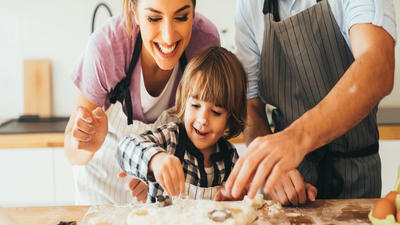
Cooking is not just a necessity; it can also be a delightful experience that fosters creativity, learning, and quality time spent together as a family. Introducing children to cooking at a young age not only equips them with valuable life skills but also creates lasting memories.
The Benefits of Cooking with Kids
Cooking with kids offers a myriad of benefits that go beyond just preparing meals. Here are some key advantages:
1. Learning and Teamwork
Cooking involves various skills, such as measuring, chopping, mixing, and following instructions. Kids learn about math (measuring ingredients), science (how heat changes food), and nutrition (identifying healthy ingredients). It also promotes teamwork, as family members work together toward a common goal.
2. Creativity and Expression
The kitchen is a great place for kids to express their creativity. They can choose their ingredients, decorate dishes, and even invent their recipes. This creative outlet fosters self-confidence and a sense of accomplishment.
3. Bonding Time
Cooking together provides an opportunity for families to bond and communicate. It encourages conversation and laughter, transforming mealtime into a joyous occasion that strengthens family connections.
4. Healthy Eating Habits
When kids participate in cooking, they are more likely to try new foods and develop a taste for healthier ingredients. Involving them in meal preparation fosters an interest in nutritious meals and teaches them about balanced diets.
5. Fun and Exploration
Cooking is a fun activity that allows children to explore different flavors, textures, and cuisines. Trying new recipes can be an exciting adventure, broadening their culinary horizons and making mealtime an engaging experience.
Tips for Cooking with Kids
Before diving into the fun recipes, here are some tips to ensure a successful and enjoyable cooking experience with children:
1. Keep It Simple
Choose recipes that are easy to follow and do not require complicated techniques. Simple recipes allow kids to participate confidently without feeling overwhelmed.
2. Safety First
Teach kids about kitchen safety, including how to use sharp utensils, handle hot equipment, and maintain cleanliness. Always supervise children, especially when using knives or cooking on the stovetop.
3. Get Everyone Involved
Assign age-appropriate tasks to each family member. Younger children can help with washing and mixing, while older kids can take on more responsibility, such as slicing fruits or measuring ingredients. Ensure everyone feels involved and valued.
4. Encourage Creativity
Allow kids to add their personal touch to recipes by suggesting ingredient substitutions or decorations. This encourages them to experiment and feel proud of their creations.
5. Make It Fun
Play music, share stories, and maintain a lighthearted atmosphere in the kitchen. Use colorful utensils and ingredients to create a visually appealing experience. Celebrate successes, and don’t be afraid to laugh at the occasional mishap.

Fun and Easy Recipes for Family Bonding
Now that you're equipped with the benefits and tips for cooking with kids, let's dive into some fun and easy recipes that you can enjoy making together. These recipes are designed to be simple, engaging, and delicious for the whole family.
1. Mini Pizzas
Ingredients:
- English muffins or pita bread
- Tomato sauce
- Shredded mozzarella cheese
- Assorted toppings (pepperoni, bell peppers, olives, mushrooms, etc.)
- Italian seasoning (optional)
Instructions:
- Preheat the oven to 400°F (200°C).
- Slice the English muffins or pita bread in half, creating individual pizza bases.
- Spread a tablespoon of tomato sauce on each base.
- Let kids sprinkle shredded mozzarella cheese over the sauce.
- Allow them to choose their favorite toppings and arrange them on top of the cheese.
- Sprinkle Italian seasoning if desired.
- Place the mini pizzas on a baking sheet and bake for about 10-12 minutes, or until the cheese is bubbly and golden.
- Let cool slightly before serving.
2. Rainbow Fruit Skewers
Ingredients:
- Assorted fruits (strawberries, orange segments, banana slices, green grapes, blueberries, and pineapple chunks)
- Wooden skewers
- Yogurt or chocolate sauce for dipping (optional)
Instructions:
- Prepare all fruits by washing, peeling, and cutting them into bite-sized pieces.
- Let kids choose a variety of fruits to create their skewers.
- Demonstrate how to safely skewer the fruit pieces onto wooden sticks, alternating colors and shapes for a visually appealing effect.
- Serve the skewers with yogurt or chocolate sauce for dipping if desired. Enjoy this healthy and colorful snack together!
3. Homemade Tacos
Ingredients:
- Small tortillas (soft or hard shell)
- Cooked ground beef or shredded chicken (seasoned with taco seasoning)
- Shredded lettuce
- Diced tomatoes
- Shredded cheese
- Sliced olives
- Sour cream or guacamole (optional)
- Salsa (optional)
Instructions:
- Set up a taco bar with all the toppings in separate bowls for kids to create their own tacos.
- Let them layer their choice of meat, lettuce, tomatoes, cheese, olives, and other toppings on the tortillas.
- Encourage creativity by allowing them to create their unique combinations.
- Enjoy the tacos together, celebrating everyone's special creations.
4. No-Bake Energy Bites
Ingredients:
- 1 cup oats
- 1/2 cup peanut butter or almond butter
- 1/3 cup honey or maple syrup
- 1/2 cup mini chocolate chips
- 1/2 cup shredded coconut (optional)
- 1/4 cup chia seeds (optional)
Instructions:
- In a large bowl, mix together oats, peanut butter, honey, and chocolate chips. Add coconut and chia seeds if desired.
- Let kids use their hands to mix everything until well combined.
- Scoop out tablespoon-sized amounts of the mixture and roll them into balls.
- Place the energy bites on a baking sheet or plate and refrigerate for at least 30 minutes to firm up.
- Enjoy these nutritious snacks as a family.
5. Colorful Vegetable Quesadillas
Ingredients:
- Flour tortillas
- Shredded cheese (cheddar, mozzarella, or a blend)
- Assorted vegetables (bell peppers, spinach, zucchini, mushrooms, etc.)
- Cooking spray or olive oil
Instructions:
- Heat a skillet over medium heat and lightly grease it with cooking spray or olive oil.
- Let kids help wash and chop the vegetables into small pieces (supervise them with knife use).
- Place a tortilla in the skillet and sprinkle half with cheese and the assorted vegetables.
- Add more cheese on top and fold the tortilla over like a half-moon.
- Cook until the cheese melts and the tortilla is golden brown on both sides, usually about 3-4 minutes per side.
- Remove from the skillet, cut into wedges, and serve with salsa or guacamole.
6. Banana Pops
Ingredients:
- 2 bananas
- 1 cup yogurt (plain or flavored)
- 1/4 cup granola or crushed nuts
- Popsicle sticks
Instructions:
- Peel the bananas and cut them in half.
- Insert popsicle sticks into the cut end of each banana half.
- Dip the bananas in yogurt until fully coated.
- Roll the yogurt-coated bananas in granola or crushed nuts.
- Place the banana pops on a baking sheet and freeze for at least two hours until solid.
- Serve frozen as a refreshing treat on a warm day.
Making Cooking a Regular Family Activity
Cooking with kids should not be a one-time experience; it can become a cherished family tradition. Here are some ideas to incorporate regular cooking sessions into your family routine:
1. Weekly Family Cooking Night
Set aside a specific night each week dedicated to cooking together. Rotate who gets to choose the recipe, allowing everyone to take turns introducing their favorites.
2. Holiday Baking Traditions
During holidays, involve kids in baking cookies, pies, or other seasonal treats. Decorating baked goods allows for fun creativity and family bonding.
3. Garden to Table
If you have space, consider starting a small vegetable or herb garden. Involve kids in the gardening process, and then use the fresh produce in your cooking. This teaches them about where food comes from and encourages them to try new flavors.
4. Cooking Challenges
Turn cooking into a fun game by hosting friendly family cooking challenges. Set a theme or ingredient that everyone must use, and then taste and rate each creation.
5. Explore World Cuisines
Introduce kids to global flavors by cooking dishes from different cultures. Learn about the history and significance of each cuisine, making it a cultural experience as well.
Conclusion
Cooking with kids is a rewarding and enriching experience that brings families together, fosters creativity, and instills essential life skills. The simple yet fun recipes shared in this blog post provide an excellent starting point for engaging your children in the kitchen. By making cooking a regular family activity, you can create lasting memories while encouraging healthy eating habits and culinary exploration. So gather your family, roll up your sleeves, and embark on this delightful journey of cooking together. Happy cooking!



